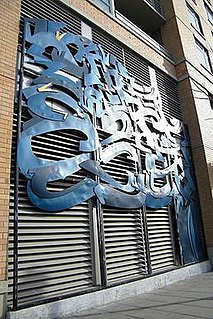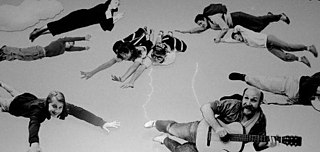
Site-specific art is artwork created to exist in a certain place. Typically, the artist takes the location into account while planning and creating the artwork. Site-specific art is produced both by commercial artists, and independently, and can include some instances of work such as sculpture, stencil graffiti, rock balancing, and other art forms. Installations can be in urban areas, remote natural settings, or underwater.
Moral rights are rights of creators of copyrighted works generally recognized in civil law jurisdictions and, to a lesser extent, in some common law jurisdictions.
Public art is art in any media whose form, function and meaning are created for the general public through a public process. It is a specific art genre with its own professional and critical discourse. Public art is visually and physically accessible to the public; it is installed or staged in public space or the public realm, usually outside. Public art seeks to embody public or universal concepts rather than commercial, partisan or personal concepts or interests. Notably, public art is also the direct or indirect product of a public process of creation, procurement, and/or maintenance.

Tilted Arc was a controversial public art installation by Richard Serra, displayed in Foley Federal Plaza in Manhattan from 1981 to 1989. The art work consisted of a 120-foot-long, 12-foot-high solid, unfinished plate of rust-covered COR-TEN steel. Advocates characterized it as an important work by a well-known artist that transformed the space and advanced the concept of sculpture, whereas critics focused on its perceived ugliness and saw it as ruining the site. Following an acrimonious public debate, the sculpture was removed in 1989 as the result of a federal lawsuit and has never been publicly displayed since, in accordance with the artist's wishes.
The Visual Artists Rights Act of 1990 (VARA),, is a United States law granting certain rights to artists.
Glassroth v. Moore, CV-01-T-1268-N, and its companion case Maddox and Howard v. Moore, CV-01-T-1269-N, 229 F. Supp. 2d 1290, affirmed, 335 F.3d 1282, concern then-Alabama Supreme Court Chief Justice Roy S. Moore and a 21⁄2 ton granite monument of the Ten Commandments in the rotunda of the Heflin-Torbert Judicial Building in Montgomery, Alabama.

Doug Aitken is an American artist. Aitken was born in Redondo Beach, California in 1968. Aitken's body of work ranges from photography, print media, sculpture, and architectural interventions, to narrative films, sound, single and multi-channel video works, installations, and live performance.
Zhao, Suikang (赵穗康) is a Chinese-American artist who works on different media and genre including painting, sculpture, site-specific installation, interdisciplinary art and monumental public art projects.
The California Art Preservation Act is a 1979 California law that provides legal protection for artists' moral rights. The law is currently codified at California Civil Code §987. The law has since been amended in part. The California Art Preservation Act was the first major law to specifically address artists' rights in the United States.

Digital DNA is a public art project commissioned by the Palo Alto Public Arts Commission for Lytton Plaza in downtown Palo Alto, California. It was created by Adriana Varella and Nilton Maltz and installed in 2005. Digital DNA addresses complicated themes of technology and public space in Silicon Valley. In 2018, the sculpture was removed from the plaza and was later installed outside of the i-Lab at Harvard Business School.

Inspiration is a public artwork by American artist Ethan Kerber, located at a commercial building at the intersection of 5th St NW & K St NW in the Mount Vernon Triangle neighborhood of Washington, D.C., United States. Inspiration was created through DC Commission on the Arts and Humanities.

Lift Off is a public artwork by American artist David Black, located at the CityVista Condominium at the intersection of 5th St NW & K St NW in the Mount Vernon Triangle neighborhood of Washington, D.C., United States. Lift Off was created through DC Commission on the Arts and Humanities.
Moral rights in United Kingdom law are parts of copyright law that protect the personal interests of the author of a copyrighted work, as well as the economic interests protected by other elements of copyright. Found in the Copyright, Designs and Patents Act 1988, the moral rights are the right to be identified as the author of a work, known as the right of paternity, the right to object to derogatory treatment of a work, known as the right of integrity, the right not to be identified as the author of someone else's work, and the right to privacy. The right of paternity exists for the entire copyright term, and requires individuals who commercially broadcast, sell, perform or exhibit literary, dramatic, musical or artistic works to identify the author of the work – but this does not apply to things such as typefaces, encyclopaedias or works subject to crown copyright.

The visual arts are art forms such as painting, drawing, printmaking, sculpture, ceramics, photography, video, filmmaking, design, crafts and architecture. Many artistic disciplines such as performing arts, conceptual art, and textile arts also involve aspects of visual arts as well as arts of other types. Also included within the visual arts are the applied arts such as industrial design, graphic design, fashion design, interior design and decorative art.

Amar Nath Sehgal v. Union of India is a landmark Indian case decided by the Delhi High Court, which for the first time upheld the moral right of an author under the Indian Copyright Act and awarded damages. The government was also asked to return his mural.
May Sun is a Los Angeles-based artist known primarily for her public art projects. Sun works in the mediums of sculpture, mixed media, photography and installation. Her work has been exhibited nationally and internationally. She was born in Shanghai, China, moved to Hong Kong at the age of two with her family and immigrated to the United States in 1971 to attend the University of San Diego. "May Sun often refers to aspects of her Chinese heritage in her work, which consistently crosses cultural and political boundaries as well as the boundaries traditionally separating art forms and disciplines."

Flight Patterns, also known informally as Flying People, is a seven-panel photographic sculpture installation of 176 black and white cutouts by David Joyce, designed to be installed in 1989 in Concourse A at the Eugene Airport in the U.S. state of Oregon. During airport construction in 2015–2016, it was moved to Lane Community College. The airport renovations were completed by early January 2017, and all but about 30 of the original Flight Patterns images were reinstalled at the airport in early December 2017.

Flight Stop, also titled Flightstop, is a 1979 site-specific art work by Canadian artist Michael Snow. Located in the Toronto Eaton Centre in Downtown Toronto, the work hangs from the ceiling and appears to depict sixty Canada geese in flight. Each individual goose is made of Styrofoam covered in fibreglass and covered in a sheath made from photographs taken from a single goose. The flock is frozen in mid-flight, "flight stop" being a pun on the nature of still photography. When conceived in 1977, the work was titled Flight Stop but has frequently also been titled Flightstop. The work remains an iconic public art piece in Toronto and in many ways stands as a visual identity for the mall.
Virginia Maksymowicz is an American artist whose sculptural installations incorporate a variety of media. She lives in Philadelphia, PA and is married to artist-photographer, Blaise Tobia.










